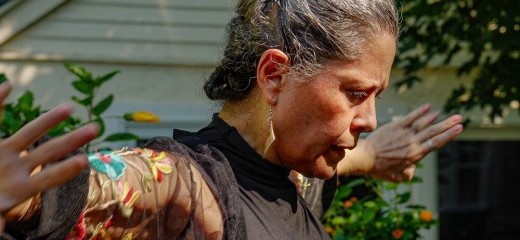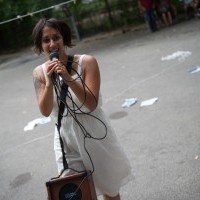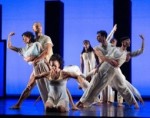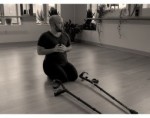
A Journey through Flamenco with Elba Hevia y Vaca
by Kristen Shahverdian
“Flamenco is a way of life” says Elba Hevia y Vaca during a virtual conversation and performance presented by Intercultural Journeys. This performance is part of Close Ups, a series of artistic presentations that provide an intimate look at an artist’s creative life. Carly Rapaport-Stein, Executive Director of Intercultural Journeys explained Close Ups as an “opportunity for artists to put their work in context with conversation and performance.” Hevia y Vaca is the second of four artists that Intercultural Journeys will present in this format.
The evening, presented on YouTube, starts with Hevia y Vaca introducing herself, moves into a pre-filmed excerpt of the piece La Bolivianita, and finishes with a live Q&A where audience members pose questions to Hevia y Vaca via the chat function. I enter Hevia y Vaca’s backyard through my screen. She sits in a cobalt blue chair next to a small round table. There is a small vase on the table filled with delicate pink flowers. The setting is inviting; I long to be there among the green grass and lush blues, pinks, and greens. Hevia y Vaca speaks to us conversationally about Flamenco and explains that she makes “works for women, and about women” where they are the “protagonists of their own stories.” Hevia y Vaca’s passion for Flamenco and her work resonates through the screen.
After Hevia y Vaca introduces herself, the screen changes to another outdoor setting, Bartram’s Garden. Hevia y Vaca walks onto a wooden stage nestled in the trees. The green leaves provide the backdrop to her stage and the glint of sun shining through the tree canopy provides the lighting. Hevia y Vaca wears all black except for the brightly colored flowers embroidered onto her long, open jacket. The sharp contrast of black against the green allows me to zero in on her. I am often distracted when performances take place in nature, but the contrasting colors and the ability of the camera to focus on Hevia y Vaca help me concentrate on her body. I am drawn into every detail, particularly her piercing eyes and the way each finger articulates as she rolls her wrists.
Hevia y Vaca begins with three different rhythmic sequences using her hands in a clapping pattern and feet against the wooden stage. Each iteration faces a different direction and, before turning, she briskly rubs her hands together. I wonder if she is trying to rub something away or get rid of something that is bothering her.
Hevia y Vaca’s performance follows a consistent pattern: she tells us about a component of Flamenco and then shows it to us in action through her body. She removes small pieces of paper that have been tucked into her shirt sleeves and pant legs and from these papers reads an element of Flamenco. “Campás,” she tells us, are the rhythm structures. After describing campás, Hevia y Vaca walks onto a square wooden plank on the stage. Her feet move quickly, creating percussive sounds, which build up until she rotates her torso and reaches her arms away from herself. This action pulls her off the plank and she stumbles, lost for a moment, and then regains her balance. Hevia y Vaca told us in her introduction that she “deconstructs Flamenco.” In this section, she shows us the campás, and then pulls away from them. I wonder about the stumbles; she is so clear and determined in her movements and her language, is the stumble an internal feeling of uncertainty or an external force acting upon her?
Her precision is particularly exciting to watch. I stare at Hevia y Vaca’s feet as they create rapid rhythmic patterns. I cannot connect the sight of her feet moving to the multitude of sounds I hear. While I marvel at her virtuosic pace, Hevia y Vaca states that precision is harder now that she is older. If Hevia y Vaca has “made sense of the world,” through Flamenco, what does the form mean to her as she ages?
Watching Hevia y Vaca, I feel I am witnessing someone with an insatiable curiosity about Flamenco’s possibilities: storytelling, passion, feminism, sexuality, emotion. She is constantly mining the material in front of us. Feminism is an important component of Hevia y Vaca’s art. She says that she understood the physical power of Flamenco from the moment she started learning it. “The stance alone,” she says, “lifting up the collarbones to the celestial.” Later she shows this in her body, standing in the center of the stage and reaching her arms to the sky—her collarbones rolling up, her heart lifting. In my bedroom, I perform a huge inhalation with her and feel my body lift and expand. When she invites us to clap with her in a specific pattern, she opens her arms in a wide circle—a “hug” she says—and encourages us to support each other through rhythm.
Near the end of the work, Hevia y Vaca share that she is partly of Andalusian heritage. This is a recent discovery. On the stage there is a red hat, a long red skirt, and a red jacket with embroidered patterns on it. She places the hat on her head and puts on the skirt. The shirt she holds up to herself, not completing the transformation yet. As this performance ends, a new journey begins.
Close Ups: Elba Hevia y Vaca, Intercultural Journeys, November 10.
By Kristen Shahverdian
November 23, 2020










